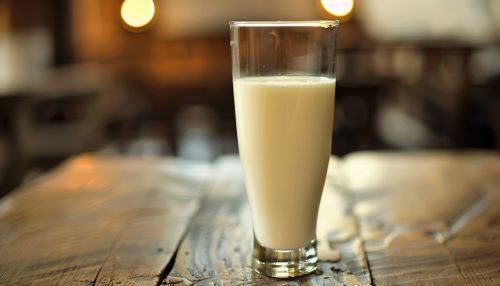Calcium in diet: Difference between revisions
(Created page with "== Introduction == Calcium is an essential mineral that plays a crucial role in various physiological processes within the human body. It is a vital component of bone and teeth structure, muscle function, nerve signaling, and blood clotting. Adequate calcium intake through diet is necessary to maintain optimal health and prevent conditions such as osteoporosis and hypocalcemia. This article delves into the importance of calcium in the diet, sources of dietary calcium, f...") |
No edit summary |
||
| Line 31: | Line 31: | ||
Dairy products such as milk, cheese, and yogurt are among the richest sources of dietary calcium. They provide highly bioavailable calcium, meaning that a significant proportion of the calcium content is absorbed by the body. For example, one cup of milk contains approximately 300 mg of calcium. | Dairy products such as milk, cheese, and yogurt are among the richest sources of dietary calcium. They provide highly bioavailable calcium, meaning that a significant proportion of the calcium content is absorbed by the body. For example, one cup of milk contains approximately 300 mg of calcium. | ||
[[Image:Detail-93019.jpg|thumb|center|A glass of milk on a wooden table.|class=only_on_mobile]] | |||
[[Image:Detail-93020.jpg|thumb|center|A glass of milk on a wooden table.|class=only_on_desktop]] | |||
=== Plant-Based Sources === | === Plant-Based Sources === | ||
Latest revision as of 21:36, 21 June 2024
Introduction
Calcium is an essential mineral that plays a crucial role in various physiological processes within the human body. It is a vital component of bone and teeth structure, muscle function, nerve signaling, and blood clotting. Adequate calcium intake through diet is necessary to maintain optimal health and prevent conditions such as osteoporosis and hypocalcemia. This article delves into the importance of calcium in the diet, sources of dietary calcium, factors affecting calcium absorption, recommended dietary allowances, and the implications of calcium deficiency and excess.
Importance of Calcium in the Diet
Calcium is indispensable for maintaining the structural integrity of bones and teeth. Approximately 99% of the body's calcium is stored in the bones and teeth, where it provides rigidity and strength. The remaining 1% is found in the blood, muscles, and intracellular fluids, where it is involved in critical physiological functions.
Bone Health
Calcium is a primary constituent of hydroxyapatite, the mineral complex that forms the bone matrix. Adequate calcium intake is essential for bone mineralization and remodeling. During periods of growth, such as childhood and adolescence, calcium is crucial for achieving peak bone mass. In adults, sufficient calcium intake helps maintain bone density and reduces the risk of osteoporosis, a condition characterized by brittle and fragile bones.
Muscle Function
Calcium plays a pivotal role in muscle contraction. It binds to troponin, a regulatory protein in muscle cells, which triggers a series of events leading to muscle contraction. Without adequate calcium, muscle function can be impaired, leading to muscle cramps and weakness.
Nerve Signaling
Calcium ions are essential for neurotransmitter release at synapses, the junctions between nerve cells. They facilitate the transmission of nerve impulses, enabling communication between neurons and the activation of muscle fibers. Disruptions in calcium homeostasis can affect nervous system function and lead to neurological disorders.
Blood Clotting
Calcium is a critical component of the blood clotting cascade. It is required for the activation of various clotting factors, which ultimately lead to the formation of a blood clot. This process is essential for preventing excessive bleeding following injury.
Sources of Dietary Calcium
Dietary calcium can be obtained from a variety of sources, including dairy products, plant-based foods, fortified foods, and supplements. The bioavailability of calcium from these sources can vary, influencing the amount of calcium absorbed by the body.
Dairy Products
Dairy products such as milk, cheese, and yogurt are among the richest sources of dietary calcium. They provide highly bioavailable calcium, meaning that a significant proportion of the calcium content is absorbed by the body. For example, one cup of milk contains approximately 300 mg of calcium.


Plant-Based Sources
Certain plant-based foods also provide calcium, although the bioavailability may be lower due to the presence of oxalates and phytates, which can inhibit calcium absorption. Leafy green vegetables such as kale, broccoli, and bok choy are good sources of calcium. Additionally, nuts, seeds, and legumes, such as almonds, chia seeds, and tofu, contribute to dietary calcium intake.
Fortified Foods
Many foods are fortified with calcium to help individuals meet their daily requirements. Commonly fortified foods include plant-based milk alternatives (e.g., almond milk, soy milk), breakfast cereals, and orange juice. The calcium in fortified foods is often in the form of calcium carbonate or calcium citrate, which have different absorption efficiencies.
Supplements
Calcium supplements are available for individuals who may not obtain sufficient calcium from their diet. These supplements come in various forms, including calcium carbonate and calcium citrate. It is important to consult with a healthcare provider before taking supplements, as excessive calcium intake can have adverse effects.
Factors Affecting Calcium Absorption
Several factors influence the absorption of calcium from the diet, including age, vitamin D status, dietary components, and physiological conditions.
Age
Age is a significant determinant of calcium absorption efficiency. Infants and young children have higher absorption rates to support rapid growth and bone development. In contrast, older adults may experience reduced calcium absorption due to age-related changes in the gastrointestinal tract.
Vitamin D
Vitamin D plays a crucial role in calcium absorption by enhancing the expression of calcium-binding proteins in the intestines. Adequate vitamin D levels are necessary for optimal calcium absorption. Sources of vitamin D include sunlight exposure, fatty fish, and fortified foods.
Dietary Components
Certain dietary components can enhance or inhibit calcium absorption. For example, lactose in dairy products can improve calcium absorption, while oxalates (found in spinach and rhubarb) and phytates (found in whole grains and legumes) can reduce absorption. Additionally, high sodium and caffeine intake can increase calcium excretion, potentially affecting calcium balance.
Physiological Conditions
Various physiological conditions, such as pregnancy, lactation, and certain medical conditions (e.g., celiac disease, inflammatory bowel disease), can influence calcium absorption and requirements. During pregnancy and lactation, calcium needs are increased to support fetal and infant development.
Recommended Dietary Allowances
The Recommended Dietary Allowances (RDAs) for calcium vary based on age, sex, and life stage. These guidelines are established by health authorities to ensure adequate calcium intake for optimal health.
Infants and Children
- 0-6 months: 200 mg/day - 7-12 months: 260 mg/day - 1-3 years: 700 mg/day - 4-8 years: 1,000 mg/day - 9-18 years: 1,300 mg/day
Adults
- 19-50 years: 1,000 mg/day - 51-70 years (males): 1,000 mg/day - 51-70 years (females): 1,200 mg/day - 71+ years: 1,200 mg/day
Pregnancy and Lactation
- 14-18 years: 1,300 mg/day - 19-50 years: 1,000 mg/day
Calcium Deficiency
Calcium deficiency, or hypocalcemia, can result from inadequate dietary intake, impaired absorption, or excessive calcium loss. It can have serious health implications, particularly for bone health.
Osteoporosis
Osteoporosis is a condition characterized by low bone mass and structural deterioration of bone tissue, leading to increased fracture risk. It is often associated with insufficient calcium intake over time. Postmenopausal women are particularly at risk due to decreased estrogen levels, which affect calcium metabolism.
Hypocalcemia
Hypocalcemia refers to abnormally low levels of calcium in the blood. Symptoms can include muscle cramps, tingling in the fingers, and cardiac arrhythmias. Severe hypocalcemia can be life-threatening and requires immediate medical attention.
Rickets and Osteomalacia
Rickets (in children) and osteomalacia (in adults) are conditions caused by impaired bone mineralization, often due to vitamin D deficiency and insufficient calcium intake. These conditions result in soft and weakened bones, leading to skeletal deformities and increased fracture risk.
Calcium Excess
Excessive calcium intake, known as hypercalcemia, can also have adverse health effects. It is typically caused by overuse of calcium supplements or certain medical conditions.
Hypercalcemia
Hypercalcemia is characterized by elevated levels of calcium in the blood. Symptoms can include nausea, vomiting, constipation, and confusion. Severe hypercalcemia can lead to kidney stones, calcification of soft tissues, and impaired kidney function.
Kidney Stones
High calcium intake, particularly from supplements, can increase the risk of kidney stones. Calcium oxalate stones are the most common type of kidney stones and can cause severe pain and urinary obstruction.
Conclusion
Calcium is a vital nutrient that plays a fundamental role in various physiological processes, including bone health, muscle function, nerve signaling, and blood clotting. Adequate dietary calcium intake is essential for maintaining overall health and preventing conditions such as osteoporosis and hypocalcemia. A balanced diet that includes a variety of calcium-rich foods, along with factors that enhance calcium absorption, can help individuals meet their calcium needs. It is important to consider age, vitamin D status, and other dietary components when assessing calcium requirements. Both calcium deficiency and excess can have significant health implications, highlighting the importance of maintaining appropriate calcium levels through diet and, if necessary, supplements.
